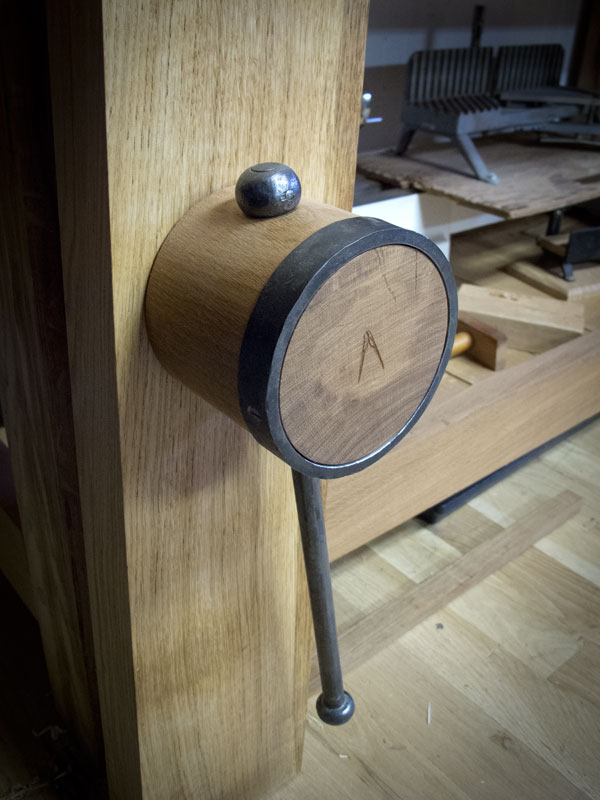We may receive a commission when you use our affiliate links. However, this does not impact our recommendations.
Last summer I built a workbench that was as close to the bench shown in A.-J. Roubo’s plate 11 as I could manage. While I still have three details to add to my bench (a drawer, a tool rack and a grease pot), the rest of the bench has been up and running since August 2013.
The leg vise is perhaps the most unusual feature of this circa 1768 workbench. As shown in Plate 11, the vise has neither a parallel guide, nor a garter. Also unusual: the vise’s jaw is quite close to the floor.
When I built this vise, I had misgivings about missing these features – the parallel guide and garter – I am so fond of. But I figured I could always modify the vise if it got too annoying.
Surprisingly, I have been pleased with the vise.
The lack of a garter (which locks the screw to the jaw) isn’t the end of the world. Yes, I have to pull the jaw back at times, which is an extra step. But I do this with my Moxon vise, and I really don’t miss the garter.
The missing parallel guide is even more of an interesting tale.
One night after a few beers, I was scouring Roubo’s text for some details on how the leg vise should work and I misread one section. (Kids: You should not drink and translate.)
Here is what Roubo actually wrote:
When you use it, you must take care to put at the base a caul of a thickness equal to that of the work, so that the head of the screw creates equal pressure everywhere….
I stupidly (perhaps drunkenly) misread that thinking that Roubo intended the caul to be tapered along its length. So the next morning I went down and used a long tapered offcut that was lying around from cutting a tapered leg.
I slid the caul left and right with my foot – no stooping, like with a parallel guide. I was impressed. So I went back upstairs and looked for the passage again and realized I had misread it. Oh well.
In any case, the tapered caul allows me to clamp a wide range of thicknesses from 0” to more than 2” with the one tapered caul. That covers 99 percent of my needs.
Later on I found out that the vise has a built-in parallel guide for larger work. I’ll deal with that feature in a future blog post. It’s happy hour here and I have some more translating to do.
— Christopher Schwarz
Here are some supplies and tools we find essential in our everyday work around the shop. We may receive a commission from sales referred by our links; however, we have carefully selected these products for their usefulness and quality.







![How To Sharpen A Gouge [Video]](https://www.popularwoodworking.com/wp-content/uploads/bfi_thumb/dummy-transparent-olcy6s63it1p9yp7uhusjas7c8kahafrhg9su7q9i0.png)


Chris, I know this is very late post on this. But, re-reading your mention on how close to the floor the bottom of the vice face came, it seemed certain that there must have been a purpose for it.
I’d bet that Roubo’s design was meant to drop a cut-off on to the floor between the face and the leg to make it parallel. Once the vice is close to the work it would take no effort slip a cut-off behind the vice face and just let it drop. You would hardly have to bend over and no fussing with adjusting mechanisms.
jb
Perhaps, a snail shaped cam with rabates in jaw or leg (both)
Pabloaa
I like the idea of no parallel guide, although I have considered the crisscross, and chain options. What about rigging something together using the Lee Valley “Vise Rack Stop”?
I use a similar trick all the time. I don’t have a “dedicated spacer” I just kick a piece of scrap in between the leg and the vice. Easy peasy.
I leave the garter out of my chops sometimes, it turns them into quick-release chops. So it goes that simple is as simple does. Too cool…
Would it help any, to minimize twisting forces on the jaw and screw, to cut a taper in the back face of the jaw at the very bottom to match the taper of the caul?
Chris, This looks like something my bench could use. What is the diameter of the screw? Would a 1 1/2 inch work?
Don’t judge it until you’ve tried it.
c
I am disappointed. The post about the reglet was fantastic. I was promised a blown mind with the second stick. After nearly two months of waiting on tenterhooks for some rediscovered ancient secret of wood-working I get. . .this. Make that sorely disappointed.